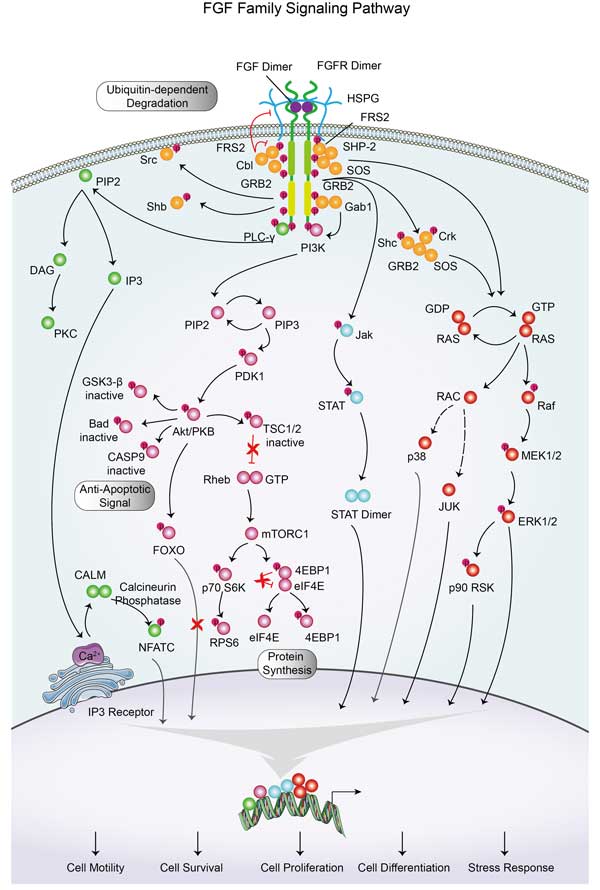Fgf15
-
Official Full Name
fibroblast growth factor 15 -
Overview
Involved in the suppression of bile acid biosynthesis through down-regulation of CYP7A1 expression, following positive regulation of the JNK and ERK1/2 cascades. Stimulates glucose uptake in adipocytes. Activity requires the presence of KLB. -
Synonyms
FGF19
Recombinant Proteins
- Mouse
- Rat
- E.coli
- Mammalian Cells
- HEK293
- His
- SUMO
- DDK
- Myc
- Avi
- Fc
| Cat.# | Product name | Source (Host) | Species | Tag | Protein Length | Price |
|---|---|---|---|---|---|---|
| Fgf15-1213M | Recombinant Mouse Fgf15 Protein, His-SUMO-tagged | E.coli | Mouse | His&SUMO | 26-218 a.a. |
|
| Fgf15-499M | Recombinant Mouse Fgf15, His-tagged | E.coli | Mouse | His |
|
|
| FGF15-5843M | Recombinant Mouse FGF15 Protein | Mammalian Cells | Mouse | His |
|
|
| Fgf15-01M | Recombinant Mouse Fgf15 Protein, His-tagged | E.coli | Mouse | His | 26-218 |
|
| Fgf15-2996M | Recombinant Mouse Fgf15 Protein, Myc/DDK-tagged | HEK293 | Mouse | DDK&Myc |
|
|
| FGF15-30R | Active Recombinant Rat FGF15 protein, His-tagged | E.coli | Rat | His |
|
|
| FGF15-3230M | Recombinant Mouse FGF15 Protein, His (Fc)-Avi-tagged | HEK293 | Mouse | Avi&Fc&His |
|
|
| FGF15-3230M-B | Recombinant Mouse FGF15 Protein Pre-coupled Magnetic Beads | HEK293 | Mouse |
|
Background
What is FGF15 protein?
FGF15 (fibroblast growth factor 15) gene is a protein coding gene which derived from mouse. It is orthologous to human FGF19 (fibroblast growth factor 19). Predicted to enable fibroblast growth factor receptor binding activity and growth factor activity. Acts upstream of or within several processes, including negative regulation of bile acid biosynthetic process; neural crest cell migration; and response to bacterium. Predicted to be located in extracellular region. Predicted to be active in cytoplasm and extracellular space. Is expressed in several structures, including brain; branchial arch endoderm; embryo ectoderm; mesonephros; and sensory organ. The FGF15 protein is consisted of 218 amino acids and its molecular mass is approximately 25.2 kDa.
What is the function of FGF15 protein?
FGF15 is involved in regulating the synthesis and metabolism of bile acids by binding to receptors in the gut. They inhibit bile acid synthesis in the liver through a negative feedback mechanism. During embryonic development, FGF15 affects ear, eye, heart and brain development. In adulthood, FGF15 is produced primarily by the ileum and acts on the liver to promote the distribution of nutrients after meals. FGF15 is involved in the regulation of glucose homeostasis by affecting the liver, brain and adipose tissue. FGF15 is also important in liver growth and regeneration, specifically playing a role in the liver's ability to regenerate after partial liver resection. It also participates in lipid metabolism and protein synthesis.
FGF15 Related Signaling Pathway
Farnitol X receptor (FXR) is a nuclear receptor that induces the secretion of fibroblast growth factor 15 (FGF15) primarily by FXR activation in the small intestine. FGF15 is transported to the liver via its receptor, the FGF receptor (FGFR), to inhibit bile acid metabolism. FGF15 activates the Hippo signaling pathway, a signaling pathway that plays a key role in cell growth and organ size control. In the liver, FGF15 activates the Hippo signaling pathway through its receptor FGFR4, thereby inhibiting the expression of the rate-limiting enzyme Cyp7a1 for bile acid synthesis and regulating bile acid metabolism. Some G protein-coupled receptors (GPCRs), such as TGR5 and MRGPRX4, are also involved in FGF15 signaling, primarily with immunomodulatory functions.
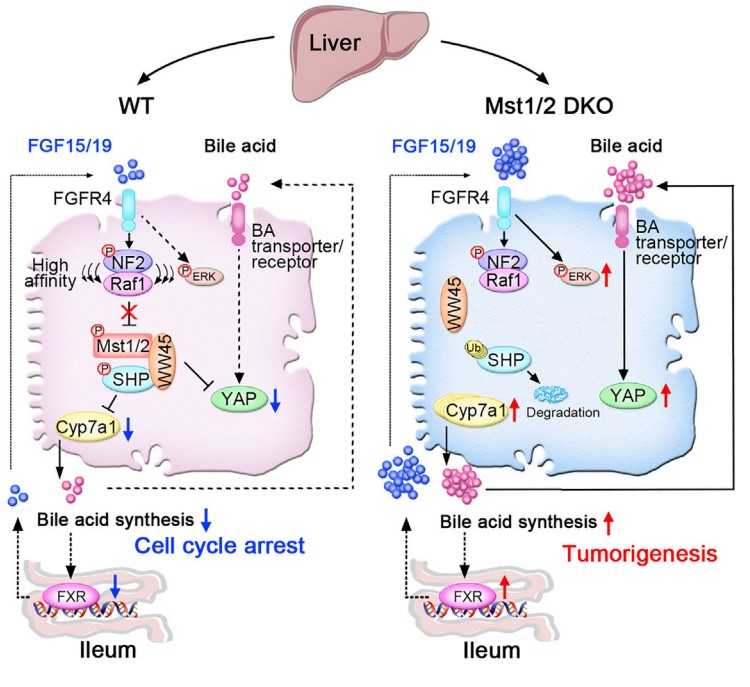
Fig1. A proposed working model for bile acid metabolism and tumor suppression mediated by the FGF15/19-Hippo signaling. (Suyuan Ji, 2019)
FGF15 Related Diseases
FGF15/19 inhibits fat production by regulating gene expression in the liver, but this regulation may be abnormal in NAFLD. FGF15/19 may play a role in obesity, affecting energy distribution and fat production by regulating gene expression in the liver. FGF15/19 may be involved in the regulation of blood glucose homeostasis and insulin action, which is related to the occurrence and development of diabetes. FGF15/19 is involved in the regulation of bile acid homeostasis and is associated with bile acid-related diseases such as primary biliary cirrhosis and biliary acid diarrhea. FGF15/19 regulates the postprandial-enterohepatic response through the bile acid-FXR-FGF15/19 signaling pathway and is relevant for the treatment of metabolic diseases. The change of FGF15/19 signal is related to the localization of intestinal inflammation in mice, and may play a role in intestinal inflammation.
Bioapplications of FGF15
In rodents, pharmacological doses of FGF19 induce the same anti-obesity and anti-diabetic effects as FGF21. Because FGF15/19 is involved in the regulation of bile acid metabolism, glucose control, and lipid metabolism, they have potential applications in the treatment of diseases such as obesity, type 2 diabetes, hepatic steatosis, biliary diseases, and cancer.
Case Study
Case Study 1: Nadejda Bozadjieva-Kramer, 2021
Bariatric surgeries such as the Vertical Sleeve Gastrectomy (VSG) are invasive but provide the most effective improvements in obesity and Type 2 diabetes. The researchers hypothesized a potential role for the gut hormone Fibroblast-Growth Factor 15/19 which is increased after VSG and pharmacologically can improve energy homeostasis and glucose handling. They generated intestinal-specific FGF15 knockout (FGF15INT-KO) mice which were maintained on high-fat diet. FGF15INT-KO mice lost more weight after VSG as a result of increased lean tissue loss. FGF15INT-KO mice also lost more bone density and bone marrow adipose tissue after VSG. The effect of VSG to improve glucose tolerance was also absent in FGF15INT-KO. VSG resulted in increased plasma bile acid levels but were considerably higher in VSG-FGF15INT-KO mice.
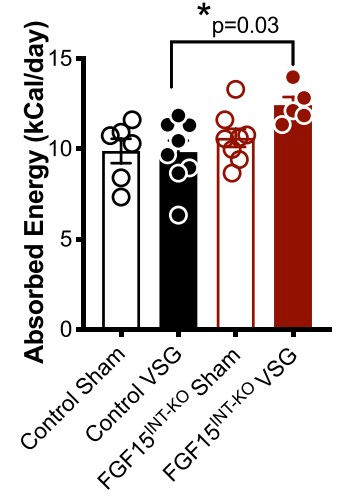
Fig1. Absorbed energy during week 11 after surgery.
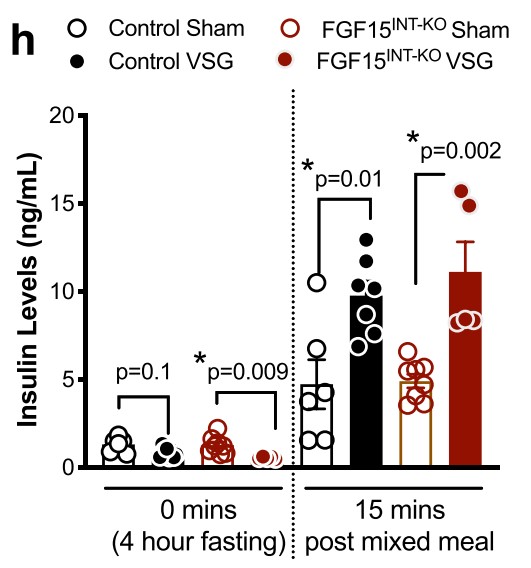
Fig2. Insulin levels at baseline (4 h fast) and 15 min post mixed meal.
Case Study 2: Alexandre Picard, 2021
The counterregulatory response to hypoglycemia is an essential survival function. It is controlled by an integrated network of glucose-responsive neurons, which trigger endogenous glucose production to restore normoglycemia. The complexity of this glucoregulatory network is, however, only partly characterized. In a genetic screen of a panel of recombinant inbred mice previously identified Fgf15, expressed in neurons of the dorsomedial hypothalamus (DMH), as a negative regulator of glucagon secretion. Here, the researchers report on the generation of Fgf15CretdTomato mice and their use to further characterize these neurons. They show that they were glutamatergic and comprised glucose-inhibited and glucose-excited neurons. When activated by chemogenetics, Fgf15 neurons prevented the increase in vagal nerve firing and the secretion of glucagon normally triggered by insulin-induced hypoglycemia. On the other hand, they increased the activity of the sympathetic nerve in the basal state and prevented its silencing by glucose overload. Higher sympathetic tone increased hepatic Creb1 phosphorylation, Pck1 mRNA expression, and hepatic glucose production leading to glucose intolerance.
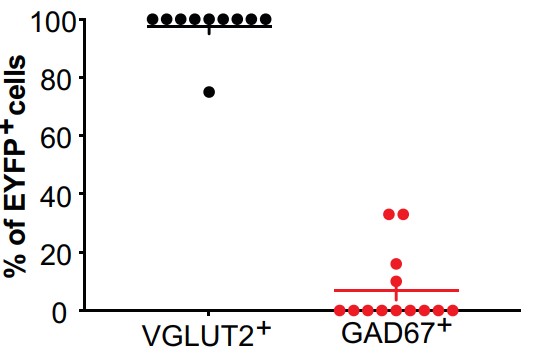
Fig3. Quantification of eYFP and vGlut2 or Gad67 double-positive Fgf15 neurons.
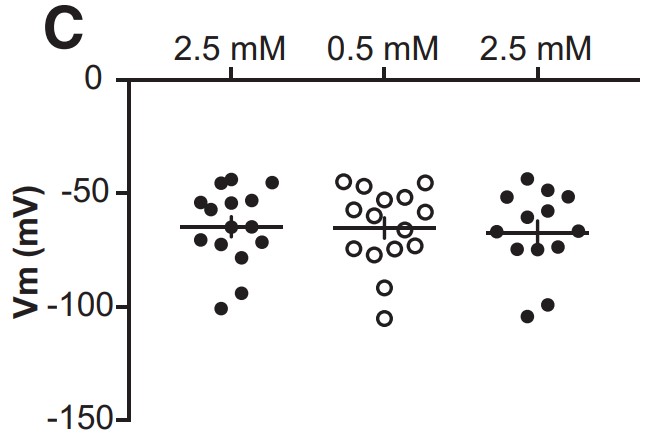
Fig4. Membrane potential of NR Fgf15 neurons.
Quality Guarantee
High Purity
.jpg)
Fig1. SDS-PAGE (Fgf15-1213M)
Involved Pathway
Fgf15 involved in several pathways and played different roles in them. We selected most pathways Fgf15 participated on our site, such as MAPK signaling pathway,Ras signaling pathway,Rap signaling pathway, which may be useful for your reference. Also, other proteins which involved in the same pathway with Fgf15 were listed below. Creative BioMart supplied nearly all the proteins listed, you can search them on our site.
| Pathway Name | Pathway Related Protein |
|---|---|
| MAPK signaling pathway | FGF6,CACNB3A,MAPK8A,MRAS,IKBKB,FGF13A,ARRB2B,CDC42L,FGF7,GNG12 |
| PIK-Akt signaling pathway | YWHAB,FGF4,IFNA13,IFNAR2,MAPK1,RHEB,TNXB,EIF4E2,TCL1A,MAP2K1 |
| Rap signaling pathway | SIPA1L2,PLCB4,PFN2,ITGA2B,MAPK13,PIK3R5,PRKCI,AKT1,F2R,CALM1 |
| Melanoma | FGF22,PDGFA,HGF,MAPK1,FGF8,FGF18,FGF17,AKT2,FGF12,FGFR1 |
| Regulation of Actin Cytoskeleton | ARPC5LB,ARHGEF7,MSNA,RAF1A,RHOAA,CDC42L2,WASLB,WASF1,FGF21,ARPC5A |
| Pathways in cancer | PIK3CA,TCF7L2,Fzd4,APC2,GNB3,GNB2,TRAF6,BDKRB2,FGF20,WNT8A |
| Ras signaling pathway | PIK3CG,GAB2,PIK3R2,PLA2G3,CALM1,GNG2,PLA2G10,GNB3,GNG11,PRKACG |
Protein Function
Fgf15 has several biochemical functions, for example, fibroblast growth factor receptor binding,growth factor activity,protein binding. Some of the functions are cooperated with other proteins, some of the functions could acted by Fgf15 itself. We selected most functions Fgf15 had, and list some proteins which have the same functions with Fgf15. You can find most of the proteins on our site.
| Function | Related Protein |
|---|---|
| receptor binding | CNTFR,NRTN,GLA,WIPI1,DVL3,CAPRIN2,MLYCD,MATK,ARRB2,FGF24 |
| fibroblast growth factor receptor binding | FGF22,FGF1A,FGF20,FGF6,FGF2,FGF8,FGF21,FGF6B,FGF10A,FGF8B |
| growth factor activity | BMP4,IL3,VEGFB,CSF1A,GDNF,IGF3,CXCL12,NDP,BMP2B,GDNFA |
| protein binding | GAL,POLR2L,AGO3,LCP2,SDHB,CRYBB1,NUP35,IL4,PFKFB2,ISG20L2 |
Interacting Protein
Fgf15 has direct interactions with proteins and molecules. Those interactions were detected by several methods such as yeast two hybrid, co-IP, pull-down and so on. We selected proteins and molecules interacted with Fgf15 here. Most of them are supplied by our site. Hope this information will be useful for your research of Fgf15.
Fgf15 Related Signal Pathway
Resources
Gene Families
Research Area
Related Services
Related Products
References


